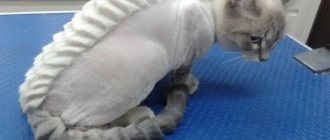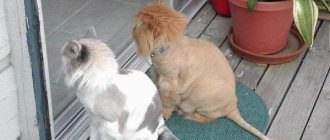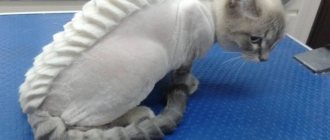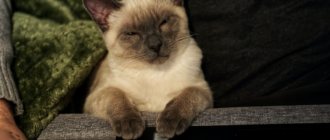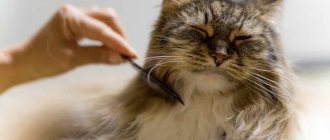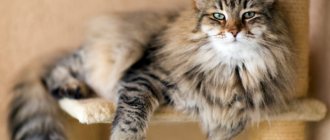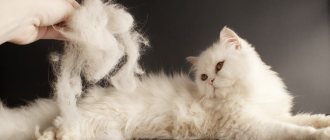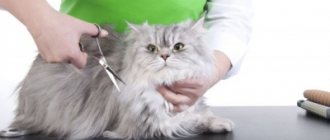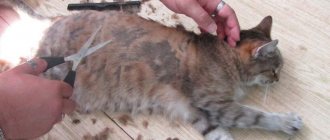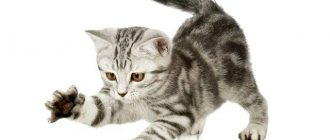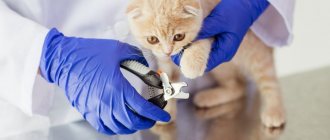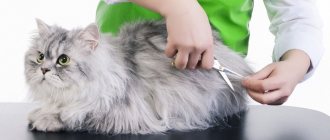Grooming a cat yourself is a responsible undertaking and should be approached with extreme caution. Grooming only makes sense if the cat is long-haired and in the summer, when it is hot. Or if a lot of mats have accumulated. Semi-longhaired, and especially shorthaired, cats do not need to be trimmed. This is unnecessary stress for them. We also do not recommend cutting an animal’s hair for “decorative” purposes, turning it into a lion or dragon simply for the sake of beauty.
How often to cut, including depending on the breed
The frequency of haircuts depends on the rate of hair growth, the age of the cat, and its health. It is recommended to cut your hair 2-3 times a year, not more often.
| Cause | Explanation |
| Hygiene | Long-haired cats get dirty very quickly, their fur rolls into lumps, and when licking, the likelihood of swallowing it is high, which can lead to problems with the digestive tract. |
| Shedding | Reducing the amount of wool on furniture. |
| Skin diseases (infections, parasites, hyperplasia of the sebaceous glands, dermatitis) | With short hair, a cat is easier to handle. |
| Exclusive view | Only for the purpose of participating in exhibitions. |
For Persians, a haircut is an ideal option, especially in the summer, as they quickly grow overgrown, and they also do not like heat.
What breeds of cats are prohibited from being cut?
- Shorthair (British, Scottish Fold). There is no particular point, only when absolutely necessary. Please note that there are long-haired types of these cats, namely British Longhair and Highland Fold, they need to be cut.
- With tipping or color-point color. After a haircut, the pet's color changes (becomes darker).
- Semi-long-haired breeds (Siberian and Norwegian forest cats, Maine Coon) do not need a haircut; you can only limit yourself to bathing and thorough combing. Their fur serves as an excellent protector from overheating and freezing. Also read how to properly bathe a cat and how to brush it on the Mister Cat portal.
In addition, you should not generally trim hyperactive pets, which are difficult to pacify and require the use of sedatives, which have a negative effect later.
To cut or not to cut
It is important to understand that not all cats can and should be subjected to this procedure. So the following are a kind of contraindication:
- colorpoint and tipping colors - as the fur grows on the back and belly, it will become several tones darker than before cutting;
- disgusting character and violent temperament, when the animal does not give in to any persuasion. Of course, you can cut it under anesthesia, but in this case, evaluate all the possible risks associated with the administration of narcotic drugs: cardiac arrest, coma, failure of the liver and kidneys. As a last resort, sedatives and muscle relaxants are used instead of drugs, but only after approval of the appropriateness of their use by a specialist and under his clear guidance;
- Without an urgent need, there is no point in cutting short-haired cats - the heat does not particularly interfere with normal life activities, and they never have mats;
- Smooth-haired animals are cut only in extreme cases, for example, when they have been worn in oil paint and it is easier to shave the animal than to try to rub off the matted multi-colored wool.
How to cut a cat's hair: types of haircuts
| Type of haircut | Description |
| Exhibition (Harlequin, Continental, Modern)
| Emphasizes the extravagance of the animal. |
| The Dragon | On the back and tail, scraps of fur are left in the form of small triangles that form a mohawk (the shape can be different). The head and limbs are not cut. |
| French lion | Used both for hygiene purposes and as a model. Great for summer. They cut off everything on the body, leaving the head intact, a small tassel at the tip of the tail, and the part below the knees on the paws. |
| Puss in Boots | They expose the entire body, bypassing the head, tail and paws. |
What to do if the cat resists and does not allow its fur to be cut?
Some owners use sedatives and sleeping pills to subdue animals. However, experts consider sleeping pills extremely dangerous for cats. Medicines can cause allergies, heart pathologies, and liver diseases in cats.
Medicines should only be used as a last resort if the haircut is carried out for the purpose of further treatment. The drugs are administered after preliminary consultation with a veterinarian. To calm an excited cat without anesthesia, the following measures are used:
- Applying a binder to the withers. The clamp is perceived by the animal as a mother's grip. The pet instinctively calms down.
- Application of a plastic collar. The device will protect the owner and helper from bites.
- Breaks between haircuts. After pausing the procedure, you should take the pet in your arms, calm it down and give it a small treat.
- Using a mechanical silent machine. However, using a manual trimmer will increase the time of the procedure and reduce its quality.
- Distraction with your favorite toy.
Under no circumstances should you:
- raise your voice;
- scold and beat your pet;
- allow other pets near the cat;
- tie paws.
[custom_ads_shortcode1]
Choosing Cat Grooming Tools
The haircut can be carried out using scissors (medium size, sharp with rounded ends) or a clipper, preferably silent, so as not to frighten the pet. The latter method is more effective and safer - there is practically no possibility of injuring the animal, and the result is guaranteed: a uniform haircut with the ability to choose the desired length of fur.
Auxiliary tools:
- soft comb;
- textile;
- hydrogen peroxide or chlorhexidine (needed if you injure an animal);
- toys and treats;
- table (or other surface).
It is better to immobilize the cat during the procedure. For example, wear a special collar. It is better for the second person to hold the cat and calm it while the first haircut is performed.
If the animal is very aggressive, it is better to visit a veterinary clinic. In some cases, anesthesia may be needed. It is worth doing it only if there is no other option. For example, a cat is covered in tangles and it’s hard for him.
Secrets of grooming at home
The owner of the cat can cut it himself, or at any time contact a specialized salon for a professional grooming of the animal. However, this opportunity is often not possible due to the lack of a salon in the city. Grooming includes not only cat grooming, but also comprehensive care in general, which includes the following procedures:
- trim claws;
- comb out tangles from wool, untangle matted areas;
- ear cleaning;
- eye wash;
- trimming hair between the toes, on the paws;
- removal of tartar and formations, cleaning of the oral cavity;
- cleaning of the excretory glands and other services.
The word “grooming” itself comes from hippology – the science of horses. A groom was a professional groom who looked after horses. Today this is the name given to specialists who care for any animal.
Additional tools
For a high-quality and efficient grooming of cats, you will need not only a tool for trimming hair (clipper or scissors), but also several additional things:
- comb-comb for preliminary and subsequent separation of strands;
- special attachments for the clipper - if the hair is long, the attachments must be at least 3 mm long, it is better to take veterinary ones;
- simple hairdressing scissors (regular or thinning);
- a product for disinfecting fur and skin - sudden movements of your pet are possible, which often leads to cuts and injuries. To prevent infections and inflammations, it is important to immediately treat the damaged area;
- a special high table or ironing board on which it will be convenient and safe to work on the cat’s hair;
- hydrogen peroxide, cotton wool to disinfect possible cuts;
- animal food.
It is worth feeding the cat in advance so that it calms down a little, and also giving treats during the grooming procedure.
During the work, it is important to create a soft, calm, harmonious environment - after all, you are dealing with cutting tools. Cats need to feel calm. Movements with the machine should be smooth and calm.
A good solution is to attract a partner who will hold and pet the cat. It is also important not to tease the cat if it is angry, not to involve it in games or irritate it with distractions.
Aggressive cat
What to do if the cat behaves aggressively, does not allow itself to be cut, twitches and is nervous? There are several options:
- choose another date for a haircut, when the “restless” days or fear of the tool have passed;
- give the cat a sedative if it is not given - inhibition of the nervous system and general relaxation after taking the medicine will simplify the solution to the problem and reduce aggression.
An experienced professional grooms cats using his own methods of handling animals, so in extreme cases there is always the option of calling a specialist.
Haircut in several passes, with breaks
Sometimes it is necessary to do the haircut in several stages if it is not possible to reduce the length of the coat at one time. You can take the cat during the day to continue grooming, this way it will even more quickly adapt to the unusual actions of its owners and allow itself to be trimmed faster.
This option is optimal in the case of a very active and curious kitten who does not like to sit still for a long time and needs to be calmed.
If you still haven’t found an effective way to trim your cat’s hair at home, you can simply leave it with its existing coat. Then you will have to constantly collect lost hair and fight fleas.
Preparing for a haircut
The preparatory steps are as follows:
- Examine the cat. If there are skin lesions, it is recommended to reschedule the haircut. However, you don’t have to do this; then the wounded area needs to be carefully trimmed so that the wound is visible.
- Wash your pet.
- Decide on a tool. It should be well pointed.
- Choose the right time. The best thing is a period of rest, since while the cat is awake, it can injure both itself and the person.
Precautions during the procedure
When cutting hair at home, you must take precautions. This is especially true for the instrument used during the procedure. The cat owner needs to be calm while grooming, otherwise his anxiety will be passed on to his pet. Remember that for long-haired cats, using scissors is ineffective. Also, to ensure normal thermoregulation of the animal, it is recommended to cut the hair not too short.
Compliance with all precautions will lead to excellent results.
However, even the most careful actions can lead to injury. If it happens that the cat was injured during a haircut, then you need to use iodine or hydrogen peroxide with cotton swabs.
Mr. Cat recommends: step-by-step instructions for grooming a cat
- Prepare all necessary tools and disinfect them.
- Trim the nails with a nail clipper or using regular nail scissors. Take the animal's paw, press on the pad and trim the claw. Read the article about how to choose a nail clipper for a cat, what they are like and how much they cost.
- Immobilize your pet by placing it on its side and holding its paws.
- In case of aggressive behavior, wear a special plastic collar.
- Immediately cut the fur from the sides, then from the back and belly. Take special care in the nipple area.
- The skin should be taut to avoid injury. It is better to remove tangles with scissors, preferably before cutting or as you find them.
- You can cut both against hair growth and along.
- At the end of the work, the cat should be wiped with a damp cloth.
Prices, advantages and disadvantages
The advantages of professional tools include high quality materials, durability, and in most cases, ease of use even for novice craftsmen or just owners.
By choosing the necessary tool according to certain parameters, the owner can forget about visiting pet salons, saving money.
The cost of scissors from the professional line starts from 500 rubles, depending on the brand and type.
Silent Scaredy Cut scissors will cost 2000-2500 rubles.
One-time visit to a groomer – from 2500 rubles.
But the professional line is not without its drawbacks.
- With a certain set of advantages (for example, an adjustable screw, rounded ends), the model may have too small a diameter of finger rings.
- Some models require periodic sharpening.
- Not all models have rounded tips, so work with such a tool should be carried out by a specialist.
- The cost of curved scissors with long blades is higher than the cost of other models.
After the haircut
As we have already said, after grooming the cat should be wiped with a damp cloth, and it is also worth combing it. As a rule, cats easily get used to their trimmed appearance. But some problems may arise:
- The cat may get injured when scratching or playing the first time after the haircut.
- May begin to lick itself more often and exhibit slight irritation.
- In rare cases, the behavior may change and aggression may appear: the cat damages furniture, defecates in inappropriate places, or attacks.
If the cat’s behavior does not return to normal on its own, then you need to contact a veterinarian.
Adviсe
Before deciding to groom your cat, you need to take into account the recommendations of experienced professionals. Thus, professional groomers advise, if possible, not to touch the tail, which is the most vulnerable part of the animal’s body.
Even minor damage to it causes enormous suffering to the pet and can negatively affect the cat’s overall well-being. You should also pay attention to the stomach, especially the lower, most tender part.
The next point that experts advise you to pay attention to is the psychological preparation of your pet. This procedure may require some time and patience from the cat owner.
So, long before the planned haircut, you need to start accustoming the animal to the table. This should be done very carefully and consistently.
To begin with, simply place the cat on the work surface, stroke its sides and back and, if possible, try to lay the pet on its side without stopping stroking. After the animal stops behaving warily on the table and responds happily to caresses, they carefully begin combing, each time increasing the time of the procedure.
If you are consistent and do not forget to regularly brush your cat on the table, then over time she will get used to the procedures and will perceive both the table and the comb quite calmly. The next important step will be to accustom your pet to the sound of a running machine. Ideally, it is better to purchase a silent device, but if this is not possible, then you can try to accustom the cat to the noise of a running electric motor. To do this, a few days before the haircut, you should turn on the clipper for a short time, while holding the pet in your arms and stroking it.
In general, grooming a cat should be perceived as an extremely last resort when the animal’s fur is hopelessly neglected and it is not possible to comb out the tangles. As for haircuts for decorative purposes, in this case it is necessary to be guided by the cat’s reaction to the procedure, while assessing the possible consequences. When performing complex show hairstyles, it is recommended to give the cat a rest and trim it in 2-3 stages.
It should also be remembered that a trimmed mustache, as well as hair inside the ears and on the head, significantly reduces the sensitivity of the smell receptors. There is no need to groom overly aggressive or overly active pets yourself. It is better to take such animals to an experienced groomer, where sedatives may be required. Thus, each owner must decide for himself whether to cut his pet’s hair or not. To do this, you need to soberly assess the benefit/harm ratio and focus primarily on the well-being and mental balance of your pet.
To learn why cats need to be groomed, watch the following video.
